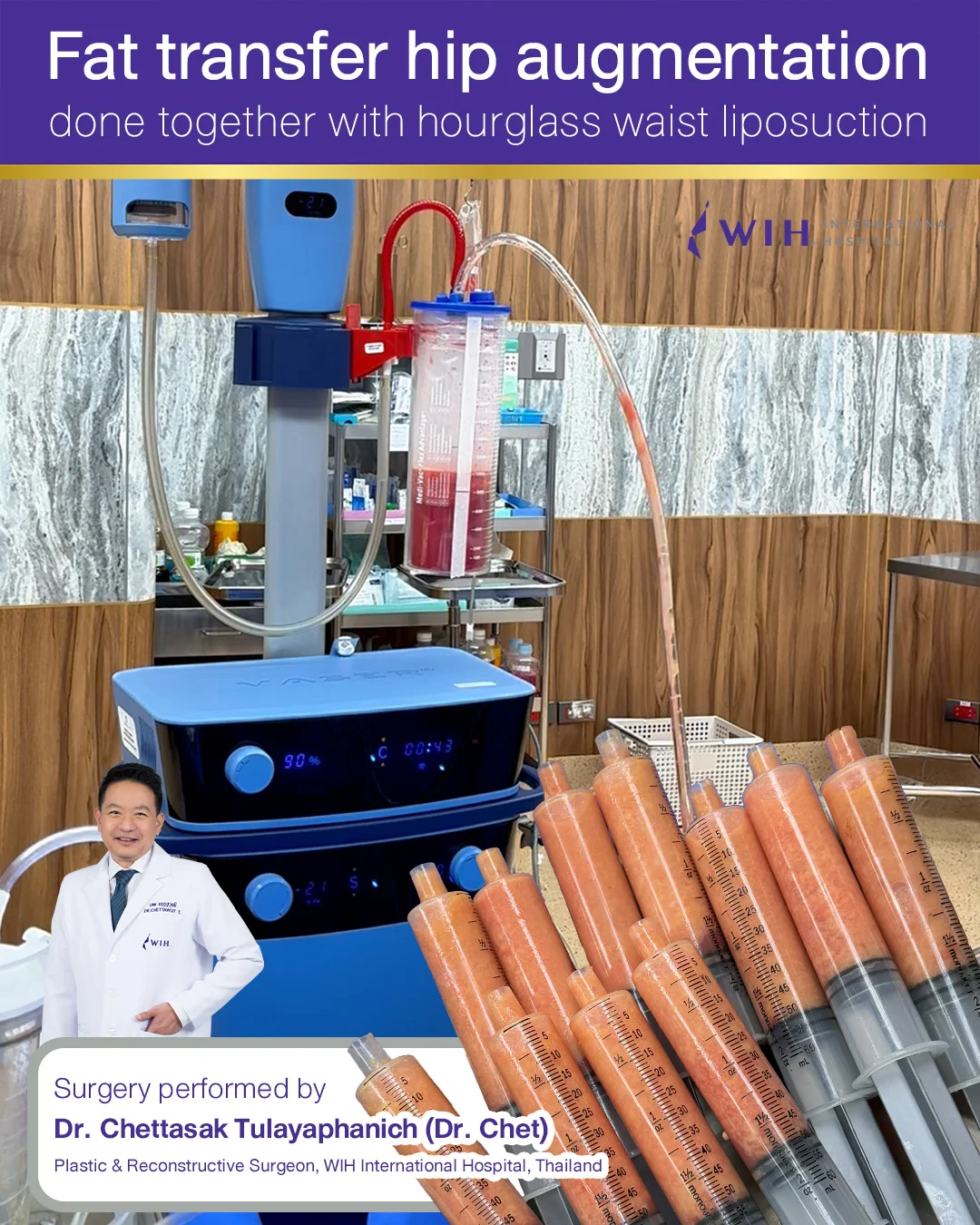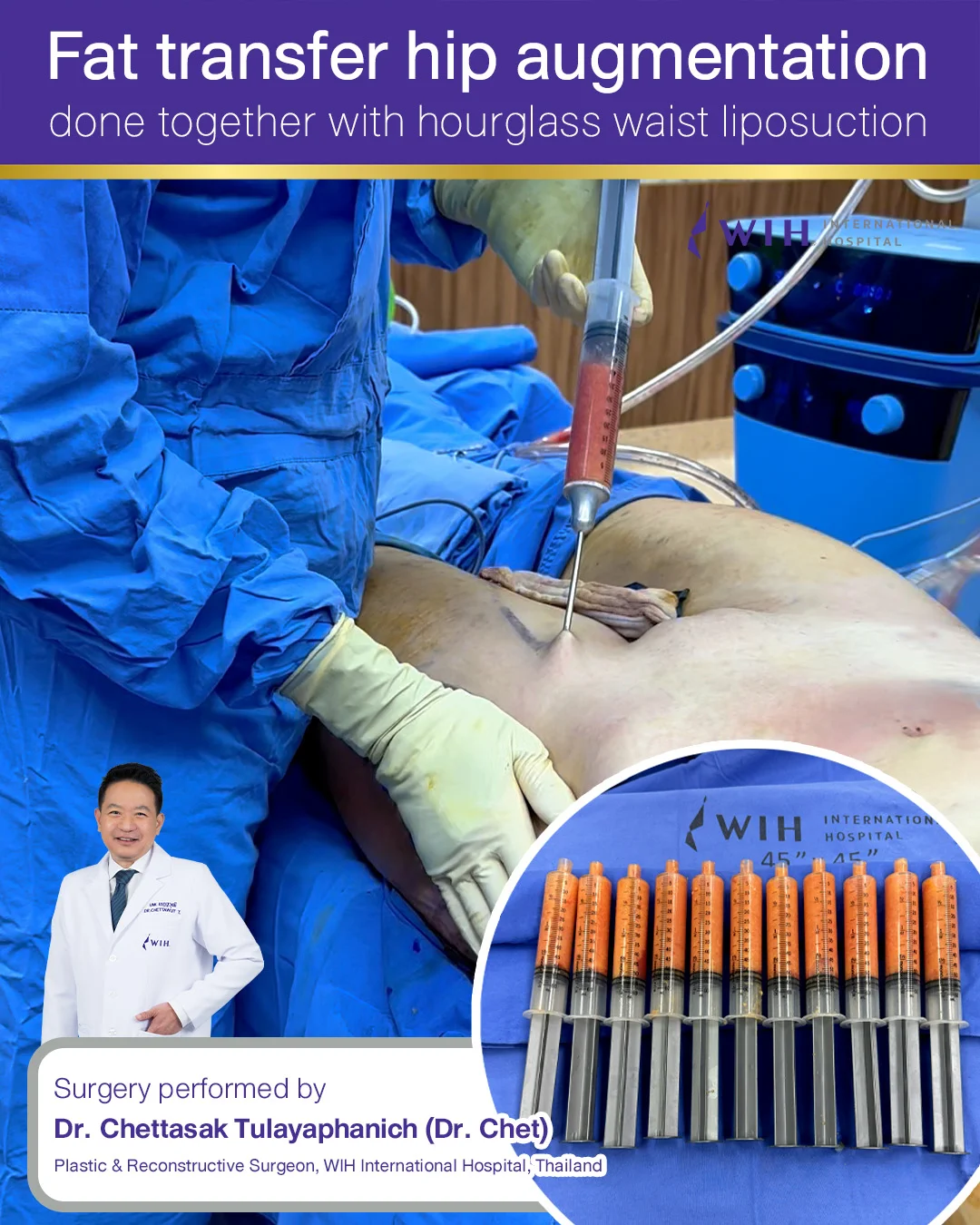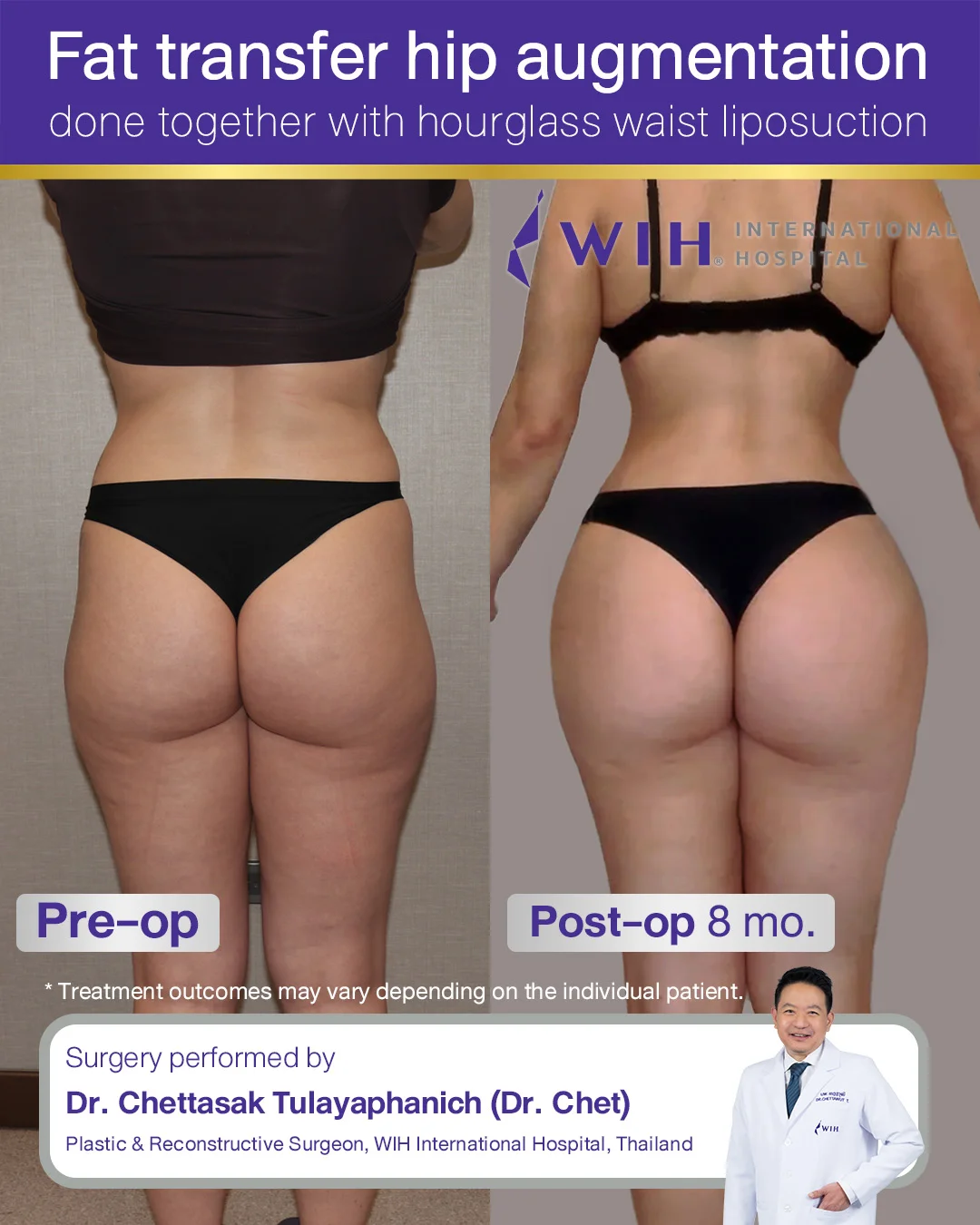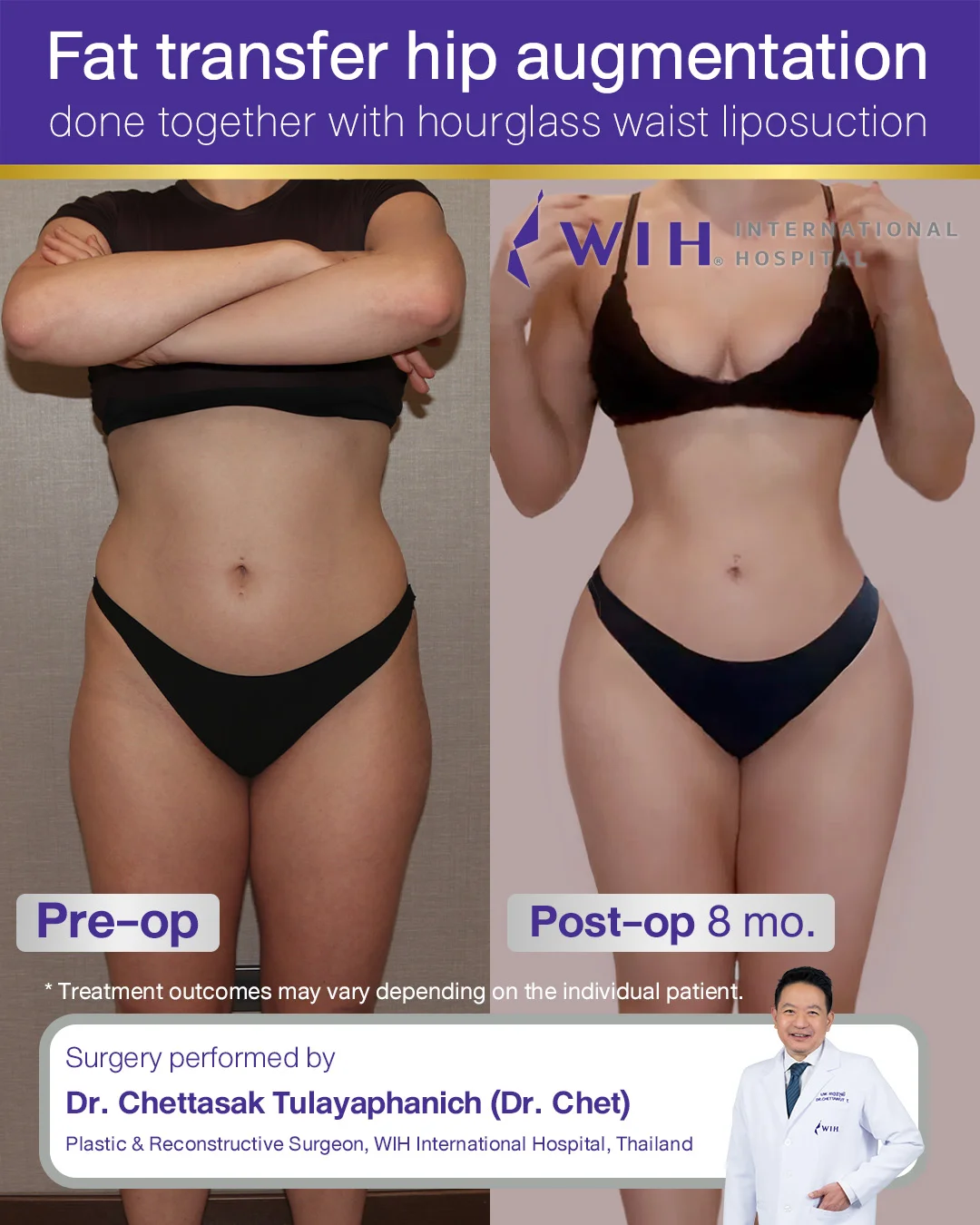Hip Augmentation is a cosmetic surgical procedure designed to enhance the hips, creating a fuller, more contoured, and aesthetically pleasing silhouette. For individuals seeking to correct “hip dips,” achieve a more hourglass figure, or simply improve their overall body proportions, this procedure offers a transformative solution. At WIH Hospital, our board-certified plastic surgeons specialize in creating natural-looking enhancements using advanced techniques, such as fat transfer and hip implants, to help you feel more confident and harmonious in your own body.
Hip Augmentation Surgery at WIH Hospital: Sculpting Balanced and Beautiful Curves
What is Hip Augmentation?
Hip Augmentation is a cosmetic surgical procedure that increases the volume, width, and projection of the hips. The goal is to create a smoother, curvier transition from the waist to the thighs, improving overall body proportion. This is primarily achieved by adding volume using either the patient’s purified fat (fat grafting) or biocompatible silicone implants
Types of Hip Augmentation Offered at WIH Hospital
Fat Transfer (Fat Grafting to Hips)
Fat is harvested via liposuction from areas with excess deposits (such as the abdomen, flanks, back, or thighs). This harvested fat is then carefully processed and purified. Then injected in multiple layers into the hip region for a natural, long-lasting result.
Recovery: swelling, bruising, and soreness in the hip area are normal. Adherence to positioning guidelines is crucial. Assistance with daily activities will be needed.
Non-Surgical Hip Augmentation (Filler Injection) Technique at WIH Hospital
At WIH International Hospital, whether due to insufficient fat for grafting or a preference for less invasive solutions, we offer non-surgical hip augmentation using advanced dermal fillers. These options provide subtle, natural-looking volume without the need for surgery or prolonged downtime.
Recovery: Minimal downtime is expected. You can usually resume most normal activities shortly after the procedure.
Combined Hip Augmentation with Buttock implants
This technique involves placing Buttock implants to achieve the primary desired volume and projection, followed by fat grafting around the implants and surrounding areas.
Recovery: Recovery may be longer compared to fat transfer alone.
Combined Hip Augmentation with Brazilian Buttock Lift
At WIH International Hospital, we offer hip augmentation combined with Brazilian Butt Lift (BBL) for patients seeking a balanced and curvaceous silhouette. This advanced procedure involves fat transfer to the hip and buttock regions.
Recovery: The recovery period may take around 2-3 weeks.
Incision Techniques for Hip Augmentation Surgery
The location and size of the incisions depend on the type of hip augmentation procedure:
- For Fat Transfer (Fat Grafting): The incisions are tiny, typically just a few millimeters, and are placed in discreet locations for both the liposuction (fat harvesting) and fat injection sites. These incisions are virtually invisible once healed.
- For Hip Implants: The incision is strategically placed to be hidden and is larger than for fat grafting. A common approach is a single incision in the buttock crease or a lateral incision in the flank area.
Who is a Good Candidate for the Surgery?
You may be a good candidate for hip augmentation if you:
- Want to correct “hip dips” or hollows on the sides of your hips.
- Seek to improve your body proportions and achieve a more curvaceous silhouette.
- Have lost hip volume due to aging or weight fluctuations.
- Have sufficient donor fat available if you are considering fat transfer.
- Have realistic expectations about the surgical outcome.
Preparation for Surgery
Consultation: A thorough consultation is essential to discuss your aesthetic goals and for the surgeon to assess your hip anatomy, skin quality, and potential fat donor sites.
Fasting: Follow all fasting guidelines provided by your medical team strictly before the surgery.
Hygiene: Shower with an antiseptic soap if recommended by your surgeon.
Avoidances: Avoid alcohol for at least a week and smoking for at least two weeks before the surgery, as these can impair the healing process.
Step-by-Step Surgical Process of Hip Augmentation
The surgical process varies depending on the technique used:
For Fat Transfer (Fat Grafting):
- Anesthesia: General anesthesia is administered for your comfort.
- Liposuction: Fat is harvested via liposuction from a designated donor area, such as the abdomen, flanks, or thighs.
- Fat Processing: The harvested fat is carefully purified to separate pure fat cells from other fluids and tissues.
- Injection: The purified fat is then meticulously injected into the hip region through small incisions, layering it to create a smooth, natural contour.
For Hip Implants:
- Anesthesia: General anesthesia is administered.
- Incision: The surgeon makes a well-concealed incision, typically in the buttock crease.
- Pocket Creation: A surgical pocket is created to fit the hip implant perfectly.
- Implant Placement: The silicone implant is carefully inserted and positioned to achieve the desired projection and shape.
- Closure: The incision is closed with sutures.
Immediate Post-Operative Instructions
Monitoring: Immediately after surgery, you will be monitored in our recovery area by our dedicated nursing staff.
Pain Management: The surgeon will prescribe pain medication to manage any pain or discomfort.
Compression Garment: For fat transfer patients, a compression garment will be applied to the liposuction sites.
Positioning: You will receive specific instructions to avoid direct pressure on the augmented areas for a specified period, which is especially crucial for fat transfer to ensure fat cell survival.
Recovery Process
- First Few Weeks: Swelling, bruising, and soreness are normal. For fat transfer, swelling in the donor and injection sites will be most noticeable. For implants, the area will be tender. Most patients can return to light activities after 1-2 weeks.
- Weeks 4-6: A significant portion of the swelling has resolved. You can gradually resume more normal activities, but avoid strenuous exercise.
- Months 2-6: The final results begin to become more apparent as swelling subsides. All normal physical activities, including exercise, can typically be resumed.
What the Patient Needs to Know About Hip Augmentation
Natural Look: Both fat transfer and implants can provide a very natural-looking and feeling result, especially when performed by an experienced surgeon.
Dual Benefit: Fat transfer offers the dual benefit of adding volume to your hips while simultaneously slimming down a donor area like the abdomen or thighs.
Long-Lasting: The results are considered long-lasting. For fat transfer, a portion of the injected fat cells will survive permanently, while implants offer a permanent solution.
Enhanced Confidence: The primary benefit for many patients is the boost in self-confidence that comes with achieving their desired body proportions.
Instructions and What to Avoid for Life-long
To ensure the longevity of your results, it’s important to:
Maintain a Stable Weight: For fat transfer, significant weight fluctuations can affect the results, as the transferred fat cells can grow or shrink.
Protect Implants: If you have implants, avoid direct, high-impact trauma to the area that could potentially dislodge or damage them.
Healthy Lifestyle: Continue to follow a healthy diet and exercise routine to maintain your overall body contour.
Potential Risks
- Infection
- Bleeding
- Hematoma
- Seroma (fluid collection)
- Blood clots (DVT)
- Poor wound healing
- Scarring
- Swelling or Bruising
Benefits of hip augmentation
- Enhanced Hip Volume and Shape
- Correction of Hip Dips
- Increased Self-Confidence
- Natural Look
- Dual Benefit
- Long-Lasting Results




FAQ
Yes, the goal is always to achieve natural-looking results that are harmonious with your body. Fat transfer generally provides a very natural look and feel.
You will experience discomfort, soreness, swelling, and bruising after surgery. This is typically most pronounced in the first week and is managed with prescribed pain medication. The level of pain varies by individual and technique
This is a critical instruction. For fat transfer, you’ll likely need to avoid direct, prolonged pressure on your hips for at least 2-3 weeks, possibly longer, to maximize fat survival. This means sleeping on your stomach or sides and using special cushions when sitting. For implants, specific positioning instructions will also be given to protect the healing area.
You’ll see an immediate change, but initial swelling will obscure the outcome. Significant swelling subsides over weeks to months. For fat transfer, it can take 3-6 months for the final volume to stabilize, as some fat is reabsorbed.
Hip dips are indentations on the side of the hips, just below the hip bone, often due to bone structure and muscle insertions. Hip augmentation, particularly with fat transfer, is very effective at filling these dips to create a smoother, more rounded outer hip contour.
Hip implants provide a permanent change in shape and volume, though factors like aging can still affect surrounding tissues. With fat transfer, the fat cells that survive the transfer process and establish a blood supply are generally permanent.



